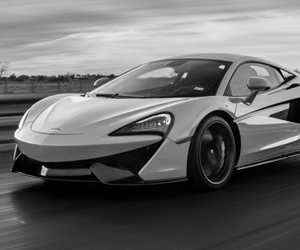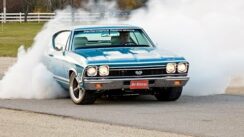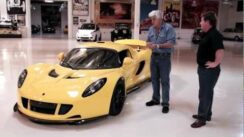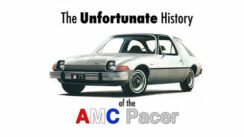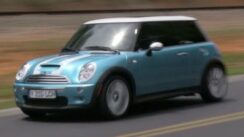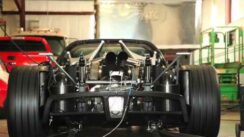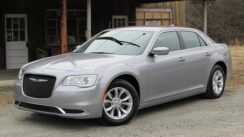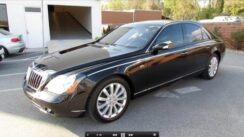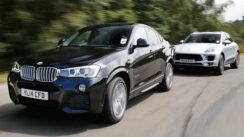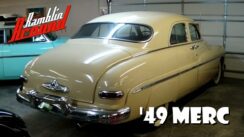2018 Jaguar F-Pace Review: An SUV with a lot to like

The world has become obsessed with SUVs. As the popularity of the SUV has risen it has eaten into the market share of wagons, vans, hatchbacks and even sedans. In this day and age, a manufacturer is doomed to lackluster sales unless they have at least one SUV offering in their lineup. It’s why even top-shelf car makes such as Bentley, Rolls-Royce and Lamborghini have succumbed to the undeniable sales boosting power of the SUV. One manufacturer which recently decided to extend their lineup with a midsize crossover SUV is Jaguar. The British manufacturer has been on a roll in recent years.
It all started with the redesigned XF, then the XJ, and finally, the well-known F-Type. These models placed Jaguar back on the map, cementing their foundation as a five-start car manufacturer. When they announced that they would take the plunge and build an SUV however, many people had their doubts. An SUV can either make or break a company, especially a prestigious one like Jaguar.
Because Jaguar is a subsidiary of Jaguar Land Rover however, they have access to the knowledge and expertise of one of the most renowned SUV builders in the world: Land Rover. When the F-Pace SUV finally landed at Frankfurt back in 2015, it turned heads and was immediately apparent that Jaguar had done their homework.
The best looking SUV on the market
The first thing you notice about the F-Pace is just how compact and small it looks. It’s a midsize crossover but its proportions give off the illusion that it’s a lot smaller than it actually is. Place it next to a Range Rover Velar, and you instantly notice that it’s actually a bit smaller than its sibling with which it shares several components. It’s about as large as a Porsche Macan, the car Jaguar was aiming the F-Pace squarely at right from the beginning.
Visually, the F-Pace is one of the most aggressive crossovers on the market. The Macan looks ordinary and boring parked next to it. Even the Velar finished in matte black with the R-Dynamic package can’t quite match it. And the F-Pace owes all of it to Jaguar’s incredible DNA. Take the front fascia for starters. The headlights are exactly the same as those you’d find on a XF, but are mounted much higher. This means that there’s a massive grill in the middle, decorated with the small Jaguar logo.
The air vents to the side are equally large. Jaguar claims they’re functional though, and aid in cooling as well as air flow. The same goes for the lower air dam. The front overhang is short, giving the F-Pace a squared stance and a rugged off-road look.
View it from the side, and you notice other similarities with the XF. It might be an SUV, but the roofline slopes down from the B-pillar just like it does in the XF. The waistline on the other hand curves up as it gets closer and closer to the rear quarter panels.
The back end has been heavily inspired by the F-Type. The taillights are basically F-Type units designed to fit the crossover body style. Given how much we’ve praised the F-Type for its gorgeous design, I doubt anyone will mind the route Jaguar went down with the F-Pace.
A cabin fit for a king
A lot of the cabin is basically a carryover from Jaguar’s sedan, the XE. The F-Pace feels like a real Jaguar from the moment you first get in. The dashboard looks familiar and so do all of the controls. Everything is ergonomically arranged and logical, unlike Jags of old. The only elements differing from those found in the XE are the door panels and the F-Pace’s new digital gauge cluster.
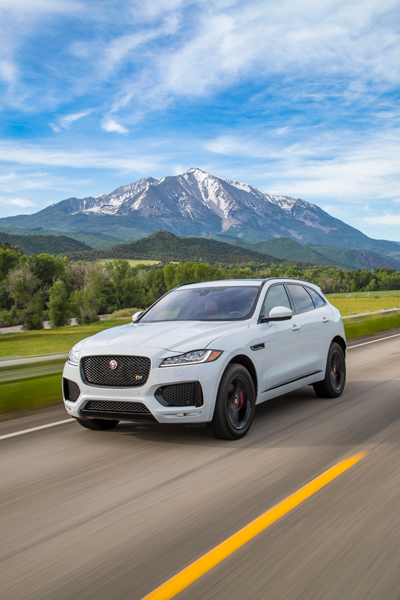 The build quality is up to par with Jaguar’s other models. Most of the materials used are premium and it uses genuine metal accents, but you can find some glossy plastics here and there if you really look around. The supple, yet supportive, leather seats feel even more special with the use of French stitching. As far as fit and finish goes, the F-Pace is more than a match for its German counterparts.
The build quality is up to par with Jaguar’s other models. Most of the materials used are premium and it uses genuine metal accents, but you can find some glossy plastics here and there if you really look around. The supple, yet supportive, leather seats feel even more special with the use of French stitching. As far as fit and finish goes, the F-Pace is more than a match for its German counterparts.
Jaguar opted to use a brand-new 10.2-inch screen for the infotainment system, and it’s a massive improvement over the old Jaguar Land Rover system. The software it uses has been updated too, so it now gets separate home pages just like a modern smartphone. You also have quick access to usual sections like radio and navigation through several graphic tiles. Again, it’s perhaps not as capable as the infotainment systems of Audi or Mercedes, but it’s a lot more user-friendly.
There’s a lot of room in both rows of seats, so you can definitely fit five adults even if it’s for shorter journeys. The trunk offers generous cargo space, but you can further improve that by folding the 60/40-split rear seats. They don’t fold completely flat, but push them down and you suddenly have room for just about anything you can think of.
Envious Performance
The F-Pace is offered with a variety of engines, and depending on the market, you can even get it with a less thirsty 2.0-liter turbocharged diesel. The gasoline range starts off with the brilliant 2.0-liter Ingenium turbocharged four-cylinder making 250 horsepower and 269 lb-ft of torque. It gets to 60 mph in 6.8 seconds and will run to 135 mph.
If that’s not enough you can also get the supercharged 3.0-liter V6 in two different guises. It’s basically the same engine as the one you find in the F-Type, here making 340 and 380 horsepower depending on the specification. Both develop 332 lb-ft of torque, but the more powerful version gets to 60 mph in 5.5 seconds, 0.3 seconds quicker than the 340 horsepower version. Naturally, they’re both limited to “just” 155 mph.
All of them use a new ZF 8HP eight-speed auto transmission. It’s a newer version of the transmission currently fitted to other Jaguars, with updated software to make it faster and smoother. The four-cylinder diesels do come available with a six-speed manual, but that’s in markets like Europe where diesel is really popular.
The F-Pace rides on Jaguar Land Rover’s modular platform, the same one used for the XE, the second-gen XF, the next-gen XJ, as well as the Velar. It features double wishbone suspension up front and multi-link in the rear (Jaguar calls it Integral Link). It’s a costly platform and system, but Jaguar wanted to make sure they did it right the first time round.
The AWD system isn’t a rework of Land Rover’s Terrain Response but rather Jaguar’s own design. Here it’s called All Surface Progress Control and allows the driver to select from four different modes: Dynamic, Normal, Eco and AdSR. The latter is short for Adaptive Surface Response and can automatically adjust the throttle, the transmission and the DSC depending on the surface the car is on. For its size and the fact that the F-Pace isn’t meant for anything other than light off-roading, it works really impressive on the trail.
Conclusion
Think of the F-Pace as the SUV XE. It’s not a full off-roader nor is it a Velar competitor. It isn’t as off-road capable as the Range Rovers, but it has that characteristic Jaguar charisma and charm. It’s practical, luxurious and actually surprisingly fast if you opt for the supercharged V6. As luxurious crossover SUV, it’s definitely the one to have (until the SVR is released). Plus, you don’t see that many of them around, making it that step-up from the common Audi and BMW you see on every corner.










































































